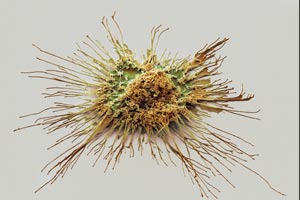
Dendritic cells, so named because of their branch-like appendages, identify foreign invaders and cancer cells in the body.
© STEVE GSCHMEISSNER/SCIENCE PHOTO LIBRARY/Getty
Dendritic cells, a type of immune cell, determine earlier than expected which kind of dendritic cells they will become — shows an A*STAR study on mice. They choose their future while still in the bone marrow.
Dendritic cells (see image) are the sentinels of the immune system. They gather information on foreign invaders such as viruses, bacteria and fungi as well as cancer cells and relay this intelligence to other parts of the immune system. A better understanding of how dendritic cells are produced would help scientists find ways to better manage the immune system, such as how to boost the immune response to infections and suppress it for autoimmune diseases such as multiple sclerosis, arthritis and inflammatory bowel disease.
“Dendritic cells are composed of two main lineages: DC1, which specialize in immunity against pathogens inside cells, and DC2, which concentrate on attackers outside cells,” explains Florent Ginhoux of the A*STAR Singapore Immunology Network. “Dendritic cells arise from progenitors in the bone marrow that give rise to circulating dendritic cell precursors, which seed peripheral tissues before differentiating into mature dendritic cells. However, how and when the decision to become DC1 or DC2 occurs remains poorly understood.”
Now, Ginhoux and co-workers have made a discovery that goes against the conventional wisdom. They found that precursors in mice make the choice to become one of the two dendritic cell subtypes early, while still in the bone marrow ― the ‘womb’ of dendritic cells ― and not, as previously thought, in the tissues where dendritic cells operate. The team used a state-of-the-art analysis method that examines gene expression profile at the single cell level — an advance on previous studies, which looked at thousands of cells in bulk.
The team also identified new dendritic cell progenitors in the bone marrow that express markers that can be used to predict their fate.
The researchers are excited about their discovery since both types of dendritic cells can potentially be harnessed for immunotherapy and vaccination. “Knowing how to identify precursors allows you to either target them or mobilize them,” says Ginhoux. “Both abilities are important, as in some diseases DC1 are the good dendritic cells, whereas in others they are the bad ones.”
“We are now trying to find out if these results are similar in humans,” says Ginhoux. “Preliminary data suggest that it will be similar, as we may have found equivalent cell populations in human blood. We are investigating this in various diseases and already we have exciting and promising results.”
The A*STAR-affiliated researchers contributing to this research are from the Singapore Immunology Network and the Genome Institute of Singapore.




